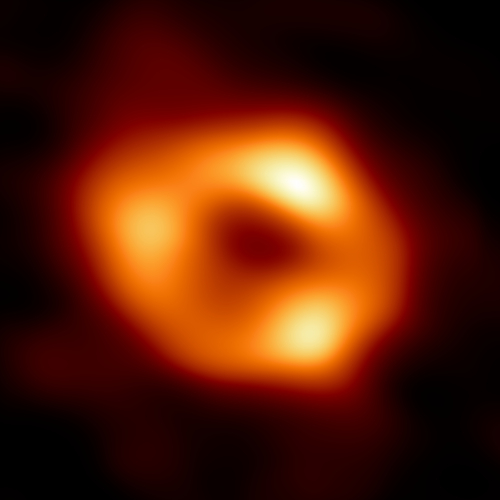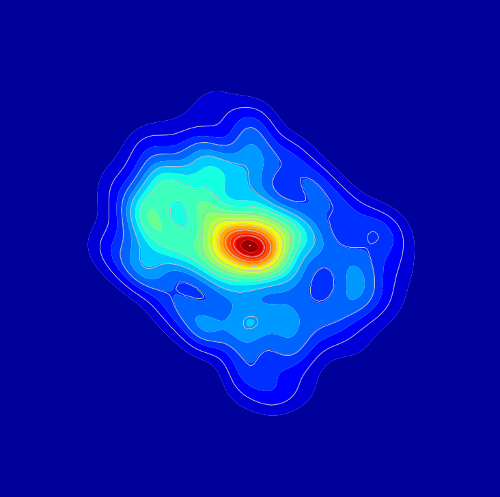The uncertainty of science: New research suggests first image in ’22 of Milky Way’s central black hole is likely not accurate

The original interpretation. Click for full image.

The new asymmetrical interpretation. Click for original image.
Surprise, surprise! A new analysis of the data behind the 2022 false-color radio image of the supermassive black hole at the center of the Milky Way, posted to the right, suggests that image was not accurately interpreted from the data.
Astronomers led by the National Astronomical Observatory of Japan (NAOJ) say their analysis points at Sagittarius A* having an elongated accretion disk, as opposed to the ring-like “doughnut” image released in 2022 by an international team called the Event Horizon Telescope (EHT) collaboration.
The EHT image shows a central dark region where the hole resides, circled by the light coming from super-heated gas accelerated by immense gravitational forces.
But a new paper published today in Monthly Notices of the Royal Astronomical Society suggests that part of this appearance may actually be an artefact because of the way the image was put together. … Assistant professor Miyoshi Makoto, of the NAOJ, said: “Our image is slightly elongated in the east-west direction, and the eastern half is brighter than the western half. We think this appearance means the accretion disk surrounding the black hole is rotating at about 60 per cent of the speed of light.” He added: “Why, then, did the ring-like image emerge? Well, no telescope can capture an astronomical image perfectly. We hypothesise that the ring image resulted from errors during EHT’s imaging analysis and that part of it was an artefact, rather than the actual astronomical structure.”
It must be noted that this false color radio image was assembled from eight different radio telescopes across the globe, and to bring the data together required a great deal of massaging. While most astronomers appear to favor the top picture, it is just as likely that the bottom picture is a better representation. Either way, both must be considered in any future studies of Sagittarius A*’s environment and structure.
On Christmas Eve 1968 three Americans became the first humans to visit another world. What they did to celebrate was unexpected and profound, and will be remembered throughout all human history. Genesis: the Story of Apollo 8, Robert Zimmerman's classic history of humanity's first journey to another world, tells that story, and it is now available as both an ebook and an audiobook, both with a foreword by Valerie Anders and a new introduction by Robert Zimmerman.
The print edition can be purchased at Amazon or from any other book seller. If you want an autographed copy the price is $60 for the hardback and $45 for the paperback, plus $8 shipping for each. Go here for purchasing details. The ebook is available everywhere for $5.99 (before discount) at amazon, or direct from my ebook publisher, ebookit. If you buy it from ebookit you don't support the big tech companies and the author gets a bigger cut much sooner.
The audiobook is also available at all these vendors, and is also free with a 30-day trial membership to Audible.
"Not simply about one mission, [Genesis] is also the history of America's quest for the moon... Zimmerman has done a masterful job of tying disparate events together into a solid account of one of America's greatest human triumphs."--San Antonio Express-News

The original interpretation. Click for full image.

The new asymmetrical interpretation. Click for original image.
Surprise, surprise! A new analysis of the data behind the 2022 false-color radio image of the supermassive black hole at the center of the Milky Way, posted to the right, suggests that image was not accurately interpreted from the data.
Astronomers led by the National Astronomical Observatory of Japan (NAOJ) say their analysis points at Sagittarius A* having an elongated accretion disk, as opposed to the ring-like “doughnut” image released in 2022 by an international team called the Event Horizon Telescope (EHT) collaboration.
The EHT image shows a central dark region where the hole resides, circled by the light coming from super-heated gas accelerated by immense gravitational forces.
But a new paper published today in Monthly Notices of the Royal Astronomical Society suggests that part of this appearance may actually be an artefact because of the way the image was put together. … Assistant professor Miyoshi Makoto, of the NAOJ, said: “Our image is slightly elongated in the east-west direction, and the eastern half is brighter than the western half. We think this appearance means the accretion disk surrounding the black hole is rotating at about 60 per cent of the speed of light.” He added: “Why, then, did the ring-like image emerge? Well, no telescope can capture an astronomical image perfectly. We hypothesise that the ring image resulted from errors during EHT’s imaging analysis and that part of it was an artefact, rather than the actual astronomical structure.”
It must be noted that this false color radio image was assembled from eight different radio telescopes across the globe, and to bring the data together required a great deal of massaging. While most astronomers appear to favor the top picture, it is just as likely that the bottom picture is a better representation. Either way, both must be considered in any future studies of Sagittarius A*’s environment and structure.
On Christmas Eve 1968 three Americans became the first humans to visit another world. What they did to celebrate was unexpected and profound, and will be remembered throughout all human history. Genesis: the Story of Apollo 8, Robert Zimmerman's classic history of humanity's first journey to another world, tells that story, and it is now available as both an ebook and an audiobook, both with a foreword by Valerie Anders and a new introduction by Robert Zimmerman.
The print edition can be purchased at Amazon or from any other book seller. If you want an autographed copy the price is $60 for the hardback and $45 for the paperback, plus $8 shipping for each. Go here for purchasing details. The ebook is available everywhere for $5.99 (before discount) at amazon, or direct from my ebook publisher, ebookit. If you buy it from ebookit you don't support the big tech companies and the author gets a bigger cut much sooner.
The audiobook is also available at all these vendors, and is also free with a 30-day trial membership to Audible.
"Not simply about one mission, [Genesis] is also the history of America's quest for the moon... Zimmerman has done a masterful job of tying disparate events together into a solid account of one of America's greatest human triumphs."--San Antonio Express-News


Why does it have an “artist formerly known as Prince” style name? Non-pronounceable characters do not belong in names.
Wikipedia knows:
The name Sagittarius A* distinguishes the compact source from the larger (and much brighter) Sagittarius A (Sgr A) region in which it is embedded. Sgr A* was discovered in 1974 by Bruce Balick [de] and Robert L. Brown, and the asterisk * was assigned in 1982 by Brown, who understood that the strongest radio emission from the center of the galaxy appeared to be due to a compact non-thermal radio object.
In addition to not knowing to blame Robert Brown, I had not known it was so recent. I suppose it’s better than Macky MacBlackHole, but only barely.
Mark Sizer: Sagittaris A* is not impronounable. It is pronounced “A-star”, as Brown first suggested from the beginning.
I try to include this factoid whenever I post about Sgr A*, but didn’t today.